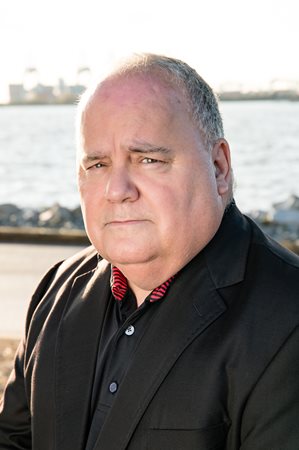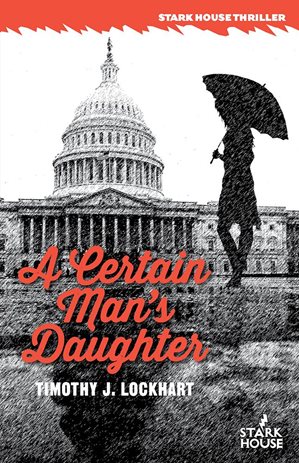Author Chats
Timothy J. Lockhart Draws on Familiar Characters to Take Readers on Crime Fiction Ride
January 24, 2023
Timothy J. Lockhart is a prodigiously productive author, publishing five novels since 2017, when his international spy thriller titled Smith was released by Stark House Press. His fifth book, Evil Intentions Come, is slated for publication later this year. Lockhart’s work taps into the ethos and tropes of pulp fiction, creating worlds populated by corrupt politicians, menacing killers, femmes fatales, and murder most foul.
international spy thriller titled Smith was released by Stark House Press. His fifth book, Evil Intentions Come, is slated for publication later this year. Lockhart’s work taps into the ethos and tropes of pulp fiction, creating worlds populated by corrupt politicians, menacing killers, femmes fatales, and murder most foul.
His third novel, A Certain Man’s Daughter, centers around protagonist Robert Shipley, a D.C. attorney hired to investigate the blackmail of a former flame turned political candidate. What follows is a rollicking adventure full of passion and betrayal: part political thriller, part detective novel.
Here, Lockhart talks about his work, writing process, influences, and thoughts on genre fiction.
A Certain Man’s Daughter is a delightfully noir tale. I came across several literary references in the book that seem to confirm a love of classic pulp detective fiction. Which writers or stories inspire your work?
Raymond Chandler was a huge influence. I discovered Chandler by accident during my very last semester of college. I saw the film The Big Sleep, with Humphrey Bogart and Lauren Bacall, late one night on TV. [It] credited Chandler as the author of the novel that was the basis for the film, and I thought it was a pretty good movie. I thought I’d go see if I could find his works.
The library had a book titled The Raymond Chandler Omnibus, which [contains] his first four novels in one volume. So, the last week of my last semester of college, pretty much all I did, when I should have been studying for finals, was devour the first four novels of Raymond Chandler.
Then I had to go off and find his other works, which led me to Dashiell Hammett, and I started reading all these great pulp fiction writers . . . Ross Macdonald, John D. MacDonald, David Goodis, Day Keene, Wade Miller . . . and I just fell in love with that type of novel. I’ve read The Postman Always Rings Twice [by James M. Cain] maybe five or six times.
Although it is the third of my books to be published, A Certain Man’s Daughter is the first [one] I ever finished writing. I started an earlier novel, but it was too autobiographical and didn’t really go anywhere. At that time, [working on] my first novel, I was very heavily influenced by all the people I had read, so I thought I would drop in a few little references to Chandler, Hammett, and Ross Macdonald. [They] are sometimes referred to as “the triumvirate” or “the big three” of detective fiction . . . not just crime fiction. Of course, A Certain Man’s Daughter is effectively a detective novel, though the protagonist is a lawyer, not technically a licensed private eye.
What were the advantages and disadvantages of using an attorney as protagonist? How much autobiography is in play?
I think most first novels are primarily autobiographical, and A Certain Man’s Daughter draws on my experiences to some extent. Some of the characters are based loosely on people I’ve known, but nobody is a direct copy. The protagonist isn’t based on me, nor is his law partner. They’re not real people disguised; they’re composites of people I’ve known.
Not all of my novels include attorneys, though my upcoming book also has an attorney protagonist. Unfortunately, my lawyer protagonists break a lot of the rules. They’re aware that they are breaking the rules and know that they will probably get into trouble, but they break them anyway. Nobody would want to read about a character that followed all the rules — that would be pretty boring.
My career has been divided into two parts. I was a Navy officer for 30 years: four years on active duty, 26 in the Reserve. I was an intelligence officer, not a JAG officer, not a lawyer for the Navy, so I often write about military figures . . . (characters who were in the military or are in the military) because I think I understand that world pretty well. And then, of course, I’ve practiced law now for 30 years, so I feel comfortable writing about lawyers and setting scenes in law firms.
I would have a very hard time writing [about] a protagonist who was a truck driver, for example. I’ve never been a truck driver. . . . You can research it, but a real truck driver would probably throw the book across the room and say, “This guy has never been behind the wheel of a big rig.”
Your novel is set in Washington, D.C., in the 1990s, with references to the Vietnam War. What considerations led you to write a period piece?
considerations led you to write a period piece?
I got my start as an attorney in the early ’90s. I was living in Northern Virginia, and at the time I was working for a large D.C. law firm. I subsequently moved to a smaller firm in Alexandria. Again, I was just writing what I knew, but I thought it would be interesting to have a modern mystery novel that had some echoes from the Vietnam War.
I’m old enough to remember the war. I didn’t serve during Vietnam. I went into the Navy in 1977, which was about five or six years after we got out of Vietnam, but I remember it. When I was in high school, I would watch protests on TV and news about how the war was going. I was very conscious of that and always thought that it would be great to have a novel with characters that had that experience.
One of the characters in my novel, the protagonist’s law firm partner, served in Vietnam. Their legal intern was born in Vietnam at the end of the war. The echoes of the war aren’t a major theme of the novel, but it’s in there.
How has your writing developed as you continue to draft and publish?
You learn a lot of little things; there’s no one big thing. When I first wrote A Certain Man’s Daughter, I would have tags for all of the dialogue. Each line was followed by “he said” or “she said,” and you can get rid of all those. The reader doesn’t need that.
If you go back and read The Postman Always Rings Twice, Cain rarely gives the dialogue a tag. He doesn’t need to. Each character has a distinctive way of speaking, and he enables the reader to follow who is speaking without all the tags.
I also had a lot of “physical business,” if you will . . . If you have two people talking at the bar, there’s a whole lot of description of “he picked up the glass” and “he moved the napkin” and “he ate a peanut,” and you don’t need all that. They’re at the bar, they order drinks, and they just start talking. You don’t need to tell the reader each time someone has a sip out of the glass.
So, you get rid of all that stuff, and you stop telling the reader what the protagonist is wearing, unless it is important. You try to strip it down to just the essentials.
You get faster by leaving out a lot of the junk you don’t need, and I think you also develop a better sense of characters and story arc. When I wrote A Certain Man’s Daughter, I had a pretty detailed outline. I don’t remember how many pages it was . . . I’ve read that the crime writer James Ellroy writes 40,000-word outlines for an 80,000-word novel.
I didn’t go that far, but it was a pretty detailed outline, and it helped me get through that first draft of my first novel. My next novel had an outline, but a pretty short one, and when I wrote [my third], I didn’t outline a thing. I understood the character and had a strong sense of the opening scene. I wrote the scene not knowing where it was going to go, what the other characters would be, or how it would end.
That really liberated me and made the writing more fun. I’d sit down every day and think, where are we going today? I really didn’t know. I’ve continued to use that process in my fourth and fifth novels. My fourth novel, Unlucky Money, is a murder mystery, and I didn’t know who the killer was until I was two-thirds of the way through!
Your fifth novel comes out in April. What is it about?
It’s called Evil Intentions Come, which is taken from a biblical quotation from the Book of Mark. Jesus is preaching and is asked about Jewish dietary law. They ask, should you eat this, should you eat that . . . Jesus says it’s not what goes into a person that defiles them, it’s what comes out of them. He says that evil intentions come from the human heart.
The book is about a kind of low-rent lawyer, out in a rural area of the Northern Neck of Virginia in a fictional town. He’s not a corporate lawyer. He’s a plaintiff’s lawyer, a trial lawyer, and not even terribly successful. He’s single and kind of a womanizer.
So, one day a beautiful woman comes to his office, and she’s wearing a white tennis dress. She’s obviously just come from playing tennis and is still a bit sweaty. She says, “I need a lawyer. I need someone to represent me in divorcing my husband. He’s abusive to me. He cheats on me all the time.” The protagonist, Pete Scarcelli, reluctantly accepts the case, but it turns out that his client has more in mind than a divorce. Without giving away too much, bad things happen for all concerned.
I hope it’s a realistic novel. I try to portray the area and the way that people live in a realistic way, but it’s definitely very noir. There’s a major plot twist that the characters, and the reader, won’t see coming.
Where can readers find your work?
They can order my books directly from the publisher, Stark House Press, from Amazon (which also lists novels for which I have written introductions), or through their local bookstores. If they want to read some reviews of my books, they can check out my author’s website at timothyjlockhart.com.


